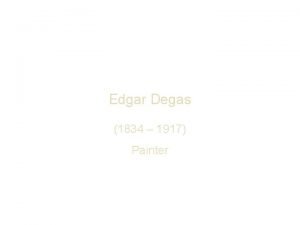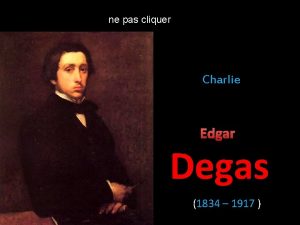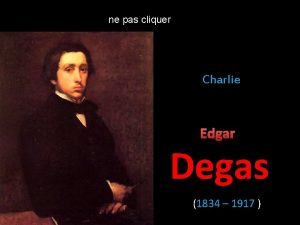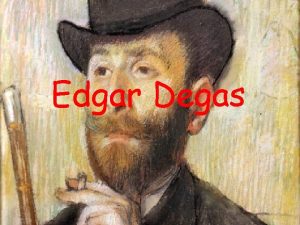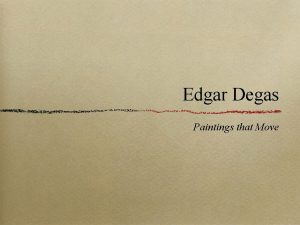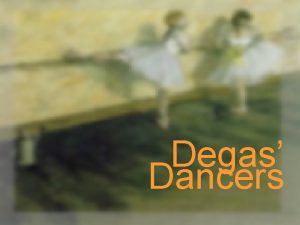EDGAR DEGAS EDGAR DEGAS 1834 1917 Edgar degas











- Slides: 11

EDGAR DEGAS

EDGAR DEGAS (1834 -1917) • • Edgar degas came from an aristocratic family background. He took part in most of the Impressionist exhibitions and was one for its most important members. His work and awkward personality set him apart from the other painters. He disliked the word ‘Impressionists’ preferring to call himself a ‘Realist’ or ‘Independent’. He also tried to capture fleeting moments in time but disliked outdoor or Plein air painting. He admired the solid traditions of the old masters but his own paintings featured scenes of modern life: racecourses, theatres and cafes. He is most famous for his countless images of dancers.

• • • He visited the Paris Opera and sketched performances of the ballet. He focused on the dancers’ gestures and poses as they practiced, waited and stretched in the rehearsal room. Later in his career he painted controversial scenes of women bathing. Degas became interested in Japanese prints and this led him to experiment with unusual angels. His subjects are often cropped at the edges. Degas enjoyed spending hours talking about art in the café Dubois with Edouard Manet and the other young artists, but he had and aloof manner and sharp tongue. He had very few close friends and apparently no love affairs. He was intensely private, particularly about his studio. Degas worked in a wide range of media including oil, watercolour, chalk, pastel, pencil, etching and photography.

Horses • Degas drew and painted all kinds of horses, including racehorses and scenes from the racetrack. • Horseracing clubs in Paris were based on the British model and were very exclusive. • Both Manet and Degas had friends among the upper classes who frequented these clubs. • The newly developed race track of Le Longchamp was one of the fashionable sites in Paris. • Degas set many of his paintings at Longchamps.

The Opera • Female dancers became degas favourite theme and he produced a huge number of paintings and pastel drawings on paper over his career. • He spent a good deal of time observing the dancers movements at the Opera and then brought the dancers to his studio. • Here he made drawings and paintings of performance on stage, groups at rehearsal resting or waiting to perform. • He also had a model spiral staircase, which can be seen in his paintings.

The Dancing Class (1873 -75) • • • This is one of the any pictures Degas created of ballet dancers. Unlike many other artists work on the same theme, Degas focuses on the informal scene of a training session of the chorus instead of a homage to the stars of the stage. Most of the dancers are shown taking a break from their rigorous training schedule while the dancing master Jules Perrot teaches one dancer her steps.

• • • The setting of the painting is the opera in the rue le Peletier in Paris which Degas visited regularly to sketch the dancers. Degas’s composition is a wonderful exploration of spatial depth. The format of the painting changed over the space of two years. Degas enhances the senses of depth in this large space by use of the floorboards to create natural perspective lines and by the carefully constructed perspective lines of the ceiling and doorway. • This is further strengthened by the use of aerial perspective as the smaller figures in the background show much less detail than the ones in the foreground. • Even the use of the colour red running through the picture, from the red bow in the girl in the foregrounds hair, to the fan in her hand further back to a hat worn by a figure at the back wall serves to unify the painting and draw our eye deep into the work.

• • The snapshot technique he was famous for is also visible here, cutting off part of the figure of the dancer on the right to create a sense of spontaneity. Degas often re-used his favourite dance poses over and over in his paintings and sketches, the figure of the dancer practising her steps appearing again in ‘Ballet Rehearsal on Stage’. The informality of this work has a fresh appeal to the viewer, as each character portrayed conveys different attitudes through their postures. The girl on the piano scratches her back, another adjusts an earring, while the seated figures in the background chat. Somewhat strangely a small dog appears at the feet of the girl in the foreground looking out at the spectator. Apprentices began official ballet classes at age seven or eight and studied long hours, with out pay for several years. They had to pass several important exams in stages, by which time they could earn more money than their fathers. Mothers looked after their daughters during these times and Degas regularly included them in his pictures.

� � L’Absinthe, 1876 This painting portrays two figures seated in a Parisian café, and provoked a storm of controversy when first sown in London in 1893. The setting for the picture was Café Nouvelles Athenes in Paris and the models were Degas fellow artist Marcellin Desboutin and actress Ellen Andree.

• • The woman, dressed in dreary tones of brown and beige, sits with a dull, glazed expression while in front of her is a glass of the absinthe (a highly alcoholic herbal drink) mentioned in the title. Beside her the man, pipe clenched between his teeth stares fixedly out of the window. Degas was often criticised for his unfeeling portrayal of the people in his paintings, and this was probably the most infamous of these. There is no idealisation of these characters, who slouch in their seats, unspeaking, giving the impression of disillusionment and boredom. This was seen as an unfit subject for an artist: the patrons of the arts had no wish to be presented with such a depressing image of working

• • • The composition of the painting is perhaps the most revolutionary aspect of the work. The figures are shown in the top-right of the picture, while the rest of the space is broken up by the large flat shapes of the table tops. The picture has the spontaneous immediacy of a quickly taken photograph, capturing a moment in time. The edges of the painting dramatically cut off the end of the mans pope, his arm and the ends of the tables. Degas’s painting is fluid and loose, blurring the features and dress of the characters. There are some darker outlining of the forms however, seen on the shoulder of the woman and the edge of the table in front of her, distinguishing his work from that of the other impressionists.















